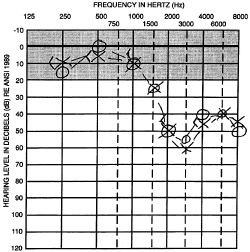Noise induced hearing loss
Early Warnings of hearing loss
- Do people "mumble" ?
- Do you frequently say "what?" or "Huh?"
- Do you misunderstand names and numbers ?
- Do you like the TV/radio volume louder ?
- Do you have trouble hearing in noisy rooms ?
Noise:
Noise is a common cause of hearing loss in the US. In many places where people work there is enough noise that it is potentially damaging to the ear. Because of this danger, there are government standards regulating the amount of noise and how long you can be exposed to that noise that can be in a work environment.
 |
This is an audiogram, or graph, of how well one person hears the different frequencies. Notice the big drop at 3000 Hz. Do you remember what the frequency range is for hearing? The unfortunate thing about the loud noises that are around us is the fact that they cause hearing loss just in the range that is important for speech. |
Noise can also cause a reversible hearing loss, called a temporary threshold shift. This typically occurs in individuals who are exposed to gunfire, firecrackers, or a rock concert. Immediately after the exposure there is ringing (tinnitus) in their ears. There is another thing that can cause hearing loss that YOU need know about. It is your portable CD player or mp3 player. Research has determined if you were working in an environment that was as loud as your player, the government regulations would limit you to only 1 hour of listening at 70% of the maximum volume level.
There are two tables below. The first one shows the peak noise levels, in decibels or dBs (that is the measure for how loud sound is) for various events. The second shows the stands set by the Occupational Safety and Health Administration (OSHA) for the amount of noise you can be exposed to at work.
| NOISE | LEVEL | |
|---|---|---|
| Firecracker | 180 | |
| Gunshot | 167 | |
| Car Stereo | 154 | |
| Children's toys | 150 | |
| Sporting events | 127 | |
| Rock Concert | 120 | |
| Health Club | 120 | |
| Motorboats | 115 | |
| Video Arcade | 110 | |
| Snowmobile | 99 | |
| Movie | 94 |
| Permissible Noise Exposure | ||
| Duration per Day (hours) | Sound Level (dBA) | |
|---|---|---|
| 8 | 90 | |
| 4 | 95 | |
| 2 | 100 | |
| 1 | 105 | |
| 1/2 | 110 | |
| 1/4 or less | 115 | |
| Maximum impact noise 140 dBA | ||
Musicians and the prevention of hearing loss:
Musical instruments can also generate considerable sound. So they too can also cause hearing loss. Most of the time the damaging frequencies created by instruments are the high-frequencies. The piccolo generates sound levels up to 112dB… about the same as a jackhammer at 30 feet. Violins and violas can also play loud enough to cause permanent hearing loss. With these instruments it is typically worse in the left ear. Can you guess why?
If you think this isn't important take note: in a study of rock and Jazz musicions, almost 3/4 of them had a hearing disorder. That is not a very good statistic if you want to keep your full hearing. So, is there anything you can do besides not playing your instrument and not listening to your music? Yes, yes, yes!! First, turn down the volume on your mp3 player and give your ears a break some time during the day. And if you play an instrument, there are a number of strategies that can be used to reduce the chance of noise injury. There are ear plugs made specifically for musicians. The "flat" ear plugs you buy in stores distort the sound you hear. So these aren't the best choice. Instead, a "vented" ear plug is designed to reduce the intensity of the higher frequencies but let the lower frequencies through. Talk to your band director, you doctor, or call your local college/university and ask for the percussionists. Professional percussionists tend to use ear plugs more ofter. But perhaps more musicians should consider their use, at least, some of the time.
Hearing Loss
Temporary Threshold Shifts
Hearing curves: Equal Loudnes tester